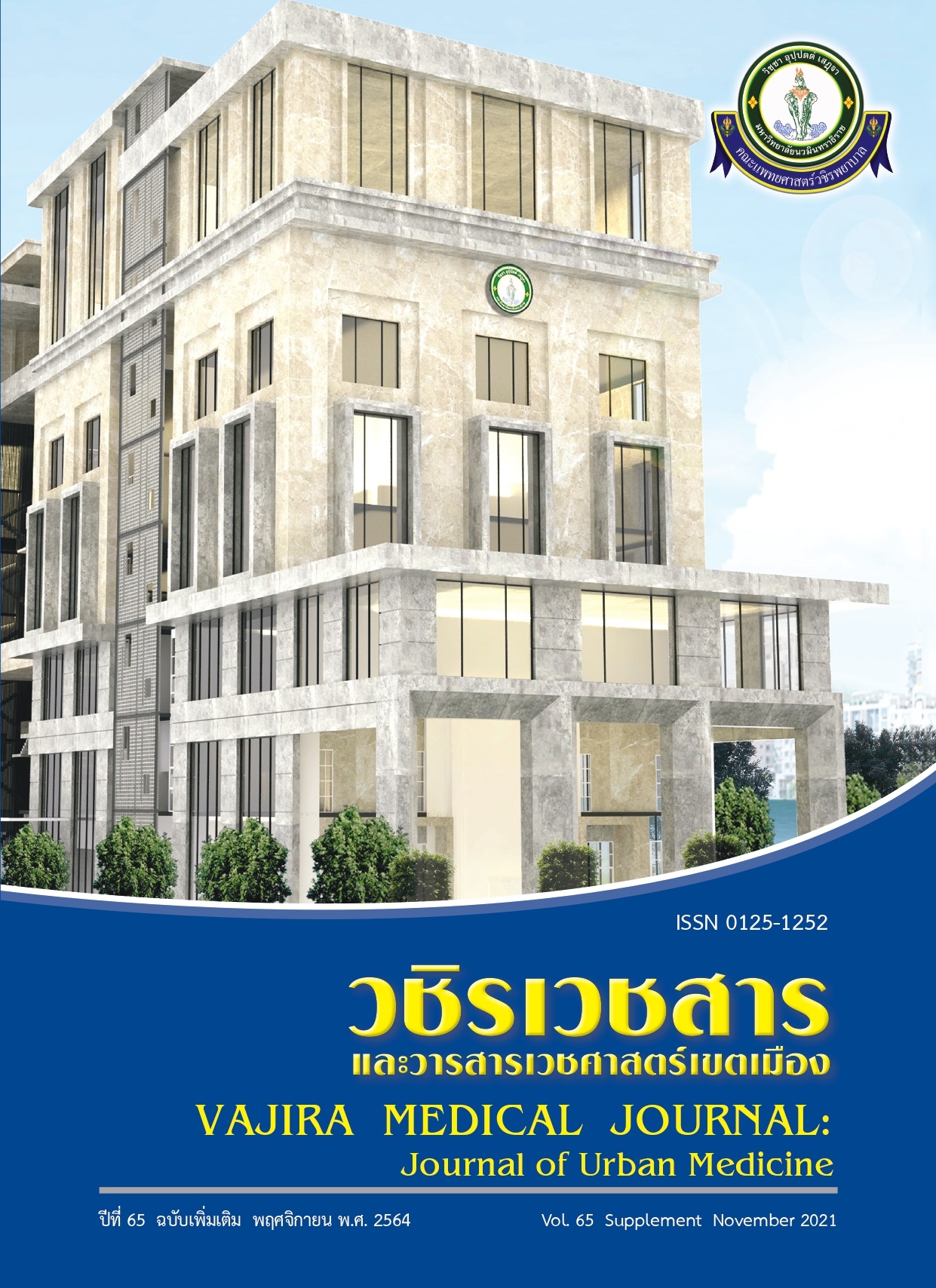Prevalence of Early Hearing Detection and Intervention Newborn in Vajira Hospital
Main Article Content
Abstract
Objectives: first objectives were to determine the prevalence of early hearing detection and intervention newborn in Vajira hospital. Secondary objectives were to study correlation of risk factors for hearing loss in newborn and to study the process of early hearing detection and intervention in Vajira hospital.
Methods: A Prospective descriptive cross-sectional study, data collected from newborns in Vajira hospital between August 2018 to July 2019. Newborns were screened with TEOAE at wards and the results were documented in medical records. The newborns who failed (“refer”) the first screening test were asked to return for repeat screening by audiologists to confirm pathological results. The total results were documented in medical records. A detailed case history, the high risk factors based on JCIH 2007, hearing screening and intervention process were obtained.
Results: Among 1,979 live births between August 2018 to July 2019, 1,946 newborns were screened with TEOAE before 1 month old and before discharge from hospital. Prevalence of early hearing screening (before 1 month old) was 1,932 newborns (97.6%). The total hearing screening referral rate was 280 newborns (14.4%). A total of newborns who failed (“refer”) the first screening test underwent complete diagnostic hearing assessment within 3 months old was 192 newborns (68.6%). Before 3 months old, 5 newborns were diagnosed with hearing loss. After being diagnosed hearing loss, they obtained an appointment to follow-up the hearing and development before 6 months old. This study did not find the hearing loss newborns who received the hearing aids or cochlear implant. We found that the overall hearing loss newborns were admitted in NICU more than 5 days and received ototoxic medications. The other risk factor was craniofacial anomalies.
Conclusions: The prevalence of early hearing detection (before 1 month old) was 97.6%. The overall prevalence of hearing loss in newborn in Vajira hospital was found to be 2.5 per 1,000 live births. This study found that total newborns who diagnosed with hearing loss were high risk group base on JCIH 2007. The prevalence of hearing intervention after diagnosis was 0%. When the results of the study were compared with indicators of JCIH 2007 and recommendation of Thailand, the efficacy of the early hearing detection and intervention newborn in Vajira hospital could almost reached all indicators. Some indicators were inferior to JCIH indicators due to many underlying factors causing the results of this study to be lower than the fact.
Downloads
Article Details

This work is licensed under a Creative Commons Attribution-NonCommercial-NoDerivatives 4.0 International License.
References
Davis A, Davis K, Mencher G. Epidemiology of permanent childhood hearing impairment. In: Newton VE, editor. Paediatric Audiological Medicine. London: Whurr; 2002. P 65-90.
Bielecki I, Horbulewicz A, Wolan T.Risk factors associated with hearing loss in infants: an analysis of 5282 referred neonates. Int J Pediatr Otorhinolaryngol 2011;75(7):925-30.
White KR, Vohr BR, Behrens TR. Universal newborn hearing screening using transient evoked otoacoustic emission: result of the Rhode Island Hearing assessment Project. Semin Hear 1993;14:18-29.
Karchmer MA, Allen TE. The functional assessment of deaf and hard of hearing students. Am Ann Deaf 1999;144(2):68-77.
American Academy of Pediatrics, Joint Committee on Infant Hearing. Year 2007 position statement: Principles and guidelines for early hearing detection and intervention programs. Pediatrics 2007; 120(4):898-921.
Northern JL, Epstein S. Neonatal hearing screening. In: Calnani AK, Grundfast KM, editors. Pediatric otology and Neurology. Philadelphia: Lippincott-Raven Publisher; 1998. P 155-62.
National Institutes of Health. Early identification of hearing impairment in infants and young children. NIH Consensus Statement 1993;11:1-24.
Chariangprasoet C, Lertsukprasert K, Kasemsuwan L, Nannarumit P. Newborn hearing screening using Otoacoustic Emission. Thai Journal of Otolaryngology Head and Neck Surgery 2003;4:27-41.
Sininger YS. Screening for hearing loss in neonates: Where do we stand? Adv Otolaryngol Head and Neck Surg 1998;12:181-203.
Bussé A, Hoeve H, Nasserinejad K, Mackey A, Simonsz H, Goedegebure A. Prevalence of permanent neonatal hearing impairment: systemic review and Bayesian meta-analysis. Int J Audiol 2020;59(6):475-85.
Connolly J, Carron J, Roark S. Universal Newborn Hearing Screening: Are we achieving the Joint Committee on Infant Hearing (JCIH) Objectives? Laryngoscope 2005;115(2):232-6.
Szyfter W, Wrobel M, Radziszewska-Konopka M, Szyfter-Harris J, Karlik M. Polish Universal neonatal hearing screening program-4-year experience (2003-2006). Int J Pediatr Otorhinolaryngol 2008;72(12):1783-7.
O-lanwanit W. Neonatal Hearing Screening Program by Otoacoustic Emission at Buriram Hospital. MEDICAL Journal of Srisaket Surin Buriram Hospitals 2011;26(2):285-94.
Chueboonchum T, Tiravanichkul R, Mongkalanunkul N, Premkraisorn W. Newborn Hearing Screening in Ramathibodi Hospital. Ramathibodi Medical Journal 2015;38:197-208. (in Thai)
Li P-C, Chen W-I, Huang C-M, Liu C-J, Chang H-W, Lin H-C. Comparison of Newborn Hearing Screening in Well-Baby Nursery and NICU: A Study Applied to Reduce Referral Rate in NICU. PLoS ONE 2016;11(3):e0152028. doi: 10.1371/journal.pone.0152028.
Thanyasiripong S. Neonatal hearing screening using Otoacoustic Emission at Ranong Hospital. Region 11 Medical Journal 2017;31(2):211-21.


